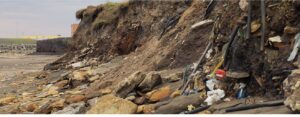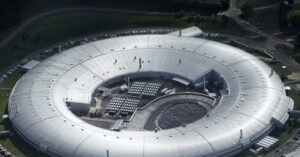Contaminant behaviour during seawater attack on legacy coastal wastes
The UK has a large legacy of waste disposal from both industrial and municipal sources. In the past much of this was disposed of with little thought about any potential environmental impacts, therefore these wastes can release contaminants into the surrounding environments. This is of particular concern in the coastal zone where, due to coastal erosion and climate changes, increases in contaminant fluxes are predicted. Preliminary assessment of hundreds of coastal waste sites has highlighted the role of mineral processing and mining wastes as potentially being the most problematic sources despite little or no understanding of how increased exposure to seawater inundation and mass weathering will affect contaminant leaching and transport processes. Industrial waste has been identified at sites across Northern England from a large range of processes, of which metallurgical slags, steel making wastes, coal spoil and metal mining wastes have been highlighted as being of concern due to their contaminant contents being present in phases that are chemically unstable and prone to leaching with seawater. Contaminants including arsenic, vanadium, copper, lead and cadmium have been detected within the wastes at these sites but it is currently unknown if spread of these materials into the coastal zone will constitute a significant risk to coastal zone habitats and vulnerable species such as invertebrates or seabirds. This project will therefore investigate waste leaching processes and speciation of the released contaminants, the nature of the remnant leached solids and the nature of any contaminant containing precipitates. The potential for uptake and accumulation in shoreline foodwebs will also be investigated.
 The project will involve intensive sampling at key sites of interest on the Cumbria, Yorkshire and Northumbria coastline and detailed laboratory based investigation of the nature of the waste materials and the fundamental processes controlling metal behaviour and ultimately environmental risks posed by these materials, providing recommendations for their future management. Training will be provided in state-of-the-art geochemical techniques such as high-resolution electron microscopy and mineralogy within the Cohen Geochemistry Group at Leeds. The student will use X-ray absorption spectroscopy to characterise the contaminant metal interactions with minerals at the molecular scale, using the world-class synchrotron radiation research sources at the UK’s Diamond Light Source. The student will benefit from collaboration with large group of other university researchers and partner organisations (from regulators and industry) as part of large UKRI funded programs on the environmental waste management. This combination of advanced training will provide the broad portfolio of skills and networks required for future employment in the academic, environmental and industrial sectors. Travel to present results at national and international meetings and conferences is also an expected part of PhD training and will be required as part of this project. The project would suit a graduate with recent experience in chemical or environmental science, environmental engineering or other equivalent subjects with a demonstrated interest in contaminant behaviour and environmental protection.
The project will involve intensive sampling at key sites of interest on the Cumbria, Yorkshire and Northumbria coastline and detailed laboratory based investigation of the nature of the waste materials and the fundamental processes controlling metal behaviour and ultimately environmental risks posed by these materials, providing recommendations for their future management. Training will be provided in state-of-the-art geochemical techniques such as high-resolution electron microscopy and mineralogy within the Cohen Geochemistry Group at Leeds. The student will use X-ray absorption spectroscopy to characterise the contaminant metal interactions with minerals at the molecular scale, using the world-class synchrotron radiation research sources at the UK’s Diamond Light Source. The student will benefit from collaboration with large group of other university researchers and partner organisations (from regulators and industry) as part of large UKRI funded programs on the environmental waste management. This combination of advanced training will provide the broad portfolio of skills and networks required for future employment in the academic, environmental and industrial sectors. Travel to present results at national and international meetings and conferences is also an expected part of PhD training and will be required as part of this project. The project would suit a graduate with recent experience in chemical or environmental science, environmental engineering or other equivalent subjects with a demonstrated interest in contaminant behaviour and environmental protection.

Specific Objectives:
- Conduct detailed sampling and high resolution characterisation of waste materials found in the UK coastal zone in order to understand the in situ nature of these materials and weathering processes.
- Laboratory based investigation of the seawater leaching process of the behaviour and fate of the risk driving contaminant elements identified for each waste type studied (e.g. As and V in coal spoil, V in steel making wastes, and Cd and Cu in mining wastes)
- Field investigation of metal concentrations in key biological components including seaweed and invertebrates exposed to fluxes of metals from waste sites to assess the potential for uptake and bioaccumulation of contaminants.
- Distal sampling of coastal sediments in the region surrounding waste sites to assess if impacts are likely to limited to just in the local environment or have regional importance.
